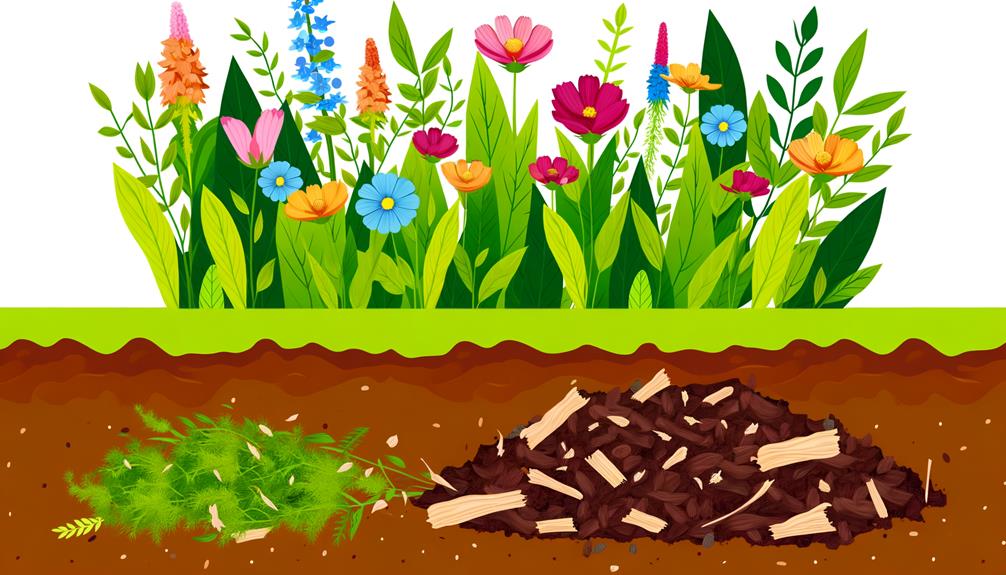To achieve rich soil fertility with organic compost, start by combining the right materials, balancing 'green' nitrogen-rich items with 'brown' carbon-rich ones. Aim for a 1:1 or 1:2 ratio and add diverse organic materials. Build your compost pile in layers, maintaining a healthy moisture level and turning it regularly. Monitor the temperature and moisture levels to guarantee ideal decomposition. By following these steps, you'll create nutrient-rich humus that'll enhance your soil and maximize its full potential. As you dig deeper, you'll uncover the secrets to a thriving ecosystem that yields robust, healthy plants.
Choosing the Right Compost Materials
When crafting your compost recipe, selecting the right mix of materials is vital to achieve a nutrient-rich soil amendment. You'll want to combine nitrogen-rich 'greens' like vegetable scraps and grass clippings with carbon-rich 'browns' such as leaves and straw. Aim for a mix of 1 part greens to 1 part browns or 1 part greens to 2 parts browns to guarantee proper decomposition and a balanced carbon to nitrogen ratio.
Including a diverse range of organic materials will enhance the nutrient diversity in your compost. Consider adding coffee grounds, eggshells, and shredded paper to the mix. Make sure to shred or chop your materials into smaller pieces to facilitate faster decomposition and create a well-aerated pile.
This will allow oxygen to penetrate the compost, promoting healthy microbial activity and a rich, fertile soil amendment. By selecting the right mix of materials, you'll be well on your way to creating a nutrient-rich compost that will enrich your soil and support healthy plant growth.
Building a Healthy Compost Pile
To build a thriving compost pile, start by layering green nitrogen-rich materials like fruit and veggie scraps and grass clippings with brown carbon-rich materials such as leaves and straw, creating a mix that's both diverse and balanced.
Aim for a ratio of 1:1 to 1:2 greens to browns to guarantee proper decomposition and nutrient content. As you build your compost pile, make sure to provide enough oxygen by turning it regularly. This aeration promotes decomposition, prevents odors, and helps maintain a healthy temperature between 110°F to 160°F.
Monitoring the temperature is essential, as it indicates the decomposition process. You'll know it's working when the pile starts to heat up. Turning the pile regularly also helps with oxygen availability and temperature control.
Remember to keep an eye on the moisture levels, aiming for a damp but not saturated environment. By following these steps, you'll be well on your way to creating a rich, fertile compost that'll enrich your soil and support healthy plant growth.
Maintaining Optimal Moisture Levels
You can easily gauge the moisture levels of your compost pile by checking its consistency, aiming for a damp, but not soggy, texture similar to a damp sponge. This ideal moisture range, between 40-60%, guarantees decomposition occurs efficiently without excess water.
If your compost is too dry, decomposition slows down, while overly wet conditions can lead to anaerobic conditions, hindering microbial activity. To maintain perfect conditions, regularly monitor the moisture content and adjust as needed by adding water or dry materials.
Properly aerated compost with ideal moisture levels promotes microbial activity, accelerating the decomposition process. By balancing moisture levels in your compost piles, you'll create an environment conducive to successful composting, ultimately producing nutrient-rich humus for rich soil fertility.
Turning the Compost for Success
By regularly turning your compost pile, you'll guarantee oxygen flows freely, supporting the decomposition process and speeding up the creation of nutrient-rich humus. This essential step is vital for maintaining a healthy composting environment, as it ensures that air circulates evenly throughout the pile.
Turning the compost pile also helps to distribute moisture and promotes the even breakdown of organic matter, which is necessary for creating a nutrient-rich soil amendment for your garden.
Weekly turning prevents overheating, which can slow down decomposition and create unpleasant odors. By mixing the compost materials regularly, you'll accelerate the breakdown process, resulting in a faster production of nutrient-rich humus.
This valuable resource is teeming with nutrients, air, and water, making it the perfect addition to your garden's soil. So, take the time to turn your compost pile regularly, and you'll be rewarded with a thriving garden that's bursting with life.
Integrating Compost Into Soil
Rich, dark compost transforms barren soil into a thriving ecosystem, teeming with life and nutrients, as you mix it into your garden beds.
As you integrate compost into your soil, you'll notice significant improvements in soil structure, allowing for better air and water movement. This, in turn, supports the growth of beneficial microorganisms that facilitate nutrient uptake in your plants.
Here are just a few benefits you can expect from incorporating compost into your soil:
- Improved soil structure, allowing for better air and water movement
- Enrichment of soil with essential nutrients like nitrogen, phosphorus, and potassium
- Enhanced moisture retention, reducing water runoff and improving drought resistance
- Promotion of beneficial microorganisms, supporting plant health and nutrient uptake
Conclusion
You've made it! With these 5 tips, you're well on your way to creating rich, fertile soil with organic compost.
You've learned how to:
- Choose the right materials
- Build a healthy compost pile
- Maintain ideal moisture
- Turn it for success
- Integrate it into your soil
Now, get out there and start composting! Your garden will thank you.
